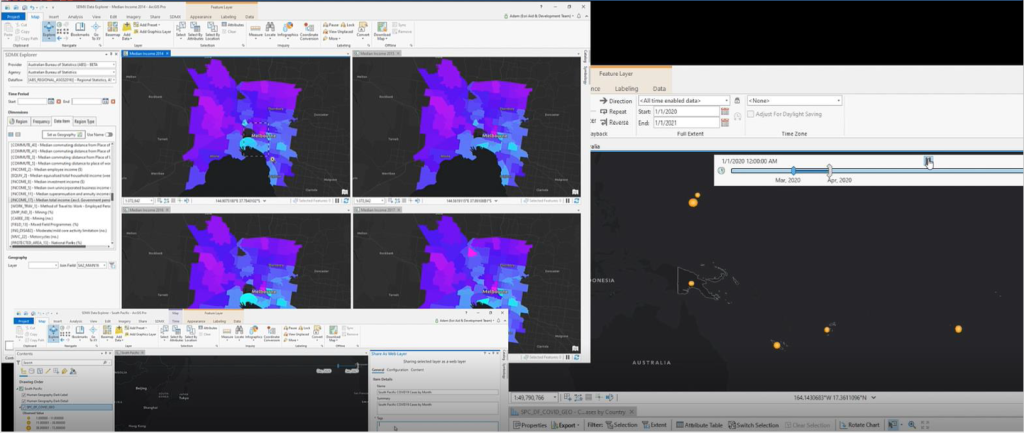The Australian Bureau of Statistics (ABS) and ESRI, a leading provider of geospatial software solutions, joined forces to leverage the .Stat Suite and the power of SDMX (Statistical Data and Metadata Exchange). Their objective was to address a number of challenges, including timely data dissemination, improved data accessibility, and improved geospatial analysis of ABS data.
The diagnosis
ABS has been facing an issue of timeliness of their data dissemination from their geospatial application, ArcGIS. The process of updating data on a monthly basis required manual interventions which could not commence until the data was formally released, leading to delays of 2-3 days in releasing geospatial representations on the ABS website. Additionally, users faced difficulties in conducting their own geospatial analysis due to the complex process of loading ABS data to geospatial software solutions.

The solution: SDMX integration
ABS has adopted SDMX APIs, powered by the .Stat Suite, as the primary channel for timely dissemination of their data. With ABS’s commitment to maximising the value of their SDMX service, and their collaborative partnership with ESRI, an opportunity arose to integrate the data drawn from their SDMX API into their geospatial visualisation tool. ABS and ESRI envisioned enabling users to seamlessly access and analyse ABS data within ArcGIS, simplifying the geospatial analysis process.

A staged approach
ABS and ESRI adopted a staged approach to their collaboration. The initial focus was on proving the concept, ensuring its feasibility, and subsequently expanding features and functionality. From the outset, the collaboration had a community-focused perspective, considering the needs of the broader SDMX community. Regular feedback from ABS guided the iterative development process, ensuring that the proof-of-concept solution met the requirements of both ABS and other potential users.
Delivering value quickly
The collaborative effort between ABS and ESRI yielded remarkable results in a relatively short period. The development team at ESRI successfully connected their software to the SDMX API, allowing seamless data extraction. This paved the way for the subsequent development of functionality to search, configure, and visualise SDMX data on a map within ArcGIS. The efficient utilisation of resources and the commitment from ESRI significantly accelerated the progress of the project.
Benefits for ABS, ESRI, and the wider Community
The integration of SDMX into ESRI’s ArcGIS software package would bring numerous benefits to all stakeholders involved. ABS users could conduct detailed geospatial analysis of ABS statistics with ease, leveraging the powerful capabilities of ESRI’s geospatial software. This collaboration serves as a testament to the value of SDMX as a platform for providing and consuming statistics. Furthermore, as more statistical organisations adopt SDMX and launch their APIs, the value of SDMX increases, encouraging software partners like ESRI to integrate and expand the SDMX ecosystem.
Scaling up
This project has worked as a pilot with the SDMX ArcGIS connector, which remains a prototype as of today. Although operational, there remains a few issues to resolve as well as an improved installation process, that would then lead to the official connector supported across the ESRI ArcGIS products. It is also important to note that the prototype was developed against SDMX 2.1. With the introduction of SDMX 3.0, as of 2022, comes a much improved support for geospatial data that would greatly ease the integration of geospatial software such as ESRI’s ArcGIS. Down on the horizon, the opportunity to scale up resides in being able to easily mash up any SDMX source data in a geospatial analysis environment.
In conclusion
The collaboration between ABS and ESRI highlights the great value that can be unlocked through the integration of SDMX and geospatial analysis. By addressing challenges such as timeliness of data dissemination, and user accessibility, ABS and ESRI have set an example for the broader statistics and data community. The successful implementation of SDMX in this context should hopefully encourage other software providers to see the value in exploring similar integrations, to unlock the full potential of an organisations data, and foster an enhanced technological and SDMX ecosystem.


